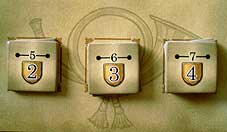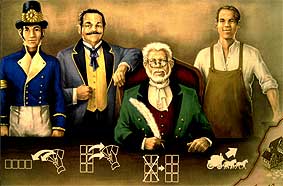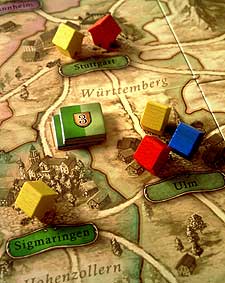Thurn und Taxis
Authors: Karen & Andreas Seyfarth
Publisher: Hans im Glück
Year: 2006
review by

| x |
|
|
|
|
|
|
|
|
|
|
|
|
|
|
|
|
|
|
|
|
|
|
|
|
|
|
|
|
|
|
|
|
|
|
|
|
|
|
|
|
|
 |
Nowadays it is not uncommon to expect our mail to be delivered in all corners of the world within a few days. The mail companies and other express services use all their efforts to achieve this in the most efficient way. It will not be a surprise to anyone that in past centuries this was not common practise. Some 500 years ago, the ‘Thurn und Taxis’ family played a major role in establishing a widespread mail deliverance network throughout large parts of Western Europe. Means of transport at that time was the stagecoach, and after every 15 kilometres it was supplied by fresh horses and a new coachman. As a result, a letter could be delivered from Innsbruck to Brussels within six days where it formerly would take two weeks or more.
In this game, two to four players try to set up their own stage coach network, connecting various cities on the board, taking presence in combinations of regions and earning points in doing so. |
| x |
|
|
|
|
|
|
|
|
|
|
|
|
|
|
|
|
|
|
|
|
|
|
|
|
|
|
|
|
|
|
|
|
|
|
|
|
|
|
|
|
|
| The map depicts Southern Germany, with smaller parts of Switzerland, Austria, Poland and the Czech Republic. Players try to make routes with their stagecoach between the 22 cities on the board, divided over 9 regions, and gather as much bonus counters as they can. |
|
 |
| x |
|
|
|
|
|
|
|
|
|
|
|
|
|
|
|
|
|
|
|
|
|
|
|
|
|
|
|
|
|
|
|
|
|
|
|
|
|
|
|
|
|
 |
|
There are bonus counters for the length of a route as well for the presence in a region. For a route that goes through 5, 6 or 7 connecting cities bonus counters can be earned, as well as for the presence in certain regions or countries. Sometimes only the presence of a single stagecoach station in an area is sufficient, sometimes all cities in an area have to be covered with stations (houses). The value of the bonuses decreases per category, so the first player who takes the first chit from a stack has a slight edge in scoring. |
| x |
|
|
|
|
|
|
|
|
|
|
|
|
|
|
|
|
|
|
|
|
|
|
|
|
|
|
|
|
|
|
|
|
|
|
|
|
|
|
|
|
|
| Each player starts with 20 small post offices in their player colour and a turn summary card. In a turn a player must draw one city card from a display of six face up cards, or draw a card from the blind stack, take that card in his hand and play one (other or the just drawn) card out of his hand and put it in front of him as the start or expansion of a route. When the route contains at least 3 cards he can score for it. Routes can only be built according the connecting roads between the cities. |
|
|
| x |
|
|
|
|
|
|
|
|
|
|
|
|
|
|
|
|
|
|
|
|
|
|
|
|
|
|
|
|
|
|
|
|
|
|
|
|
|
|
|
|
|
 |
|
A player additionally may use one of the following characters:
• The postmaster, allows a draw of 2 cards instead of 1
• The courier, allows a player to play 2 cards instead of 1
• The administrator, allows a player to exchange all cards in the display
• The cartwright, allows a player to acquire a higher value carriage with a route of 2 fewer city cards than necessary
|
| x |
|
|
|
|
|
|
|
|
|
|
|
|
|
|
|
|
|
|
|
|
|
|
|
|
|
|
|
|
|
|
|
|
|
|
|
|
|
|
|
|
|
| Players may only build on one route at a time. This is done by placing the city card(s) in their turn in front of them, according the connections between the cities that are depicted on the mapboard. Every city card may only once be part of the actual route (but may again be used in a future route). When a player has a minimum of three city cards in his route, the route may be expanded or the player scores it.
|
|
 |
| x |
|
|
|
|
|
|
|
|
|
|
|
|
|
|
|
|
|
|
|
|
|
|
|
|
|
|
|
|
|
|
|
|
|
|
|
|
|
|
|
|
|
| x |
|
|
|
|
|
|
|
|
|
|
|
|
|
|
|
|
|
|
|
|
|
|
|
|
|
|
|
|
|
|
|
|
|
|
|
|
|
|
|
|
|
 |
|
|
|
|
|
|
|
|
|
|
|
|
|
|
|
|
|
|
|
|
|
|
|
|
|
|
|
|
|
|
|
|
|
|
|
|
|
 |
|
|
|
|
|
|
|
|
|
|
|
|
|
|
|
|
|
|
|
|
|
|
|
|
|
|
|
|
|
|
|
|
|
|
|
|
|
 |
|
|
|
|
|
|
|
|
|
|
|
|
|
|
|
|
|
|
|
|
|
|
|
|
|
|
|
|
|
|
|
|
|
|
|
|
|
| x |
|
|
|
|
|
|
|
|
|
|
|
|
|
|
|
|
|
|
|
|
|
|
|
|
|
|
|
|
|
|
|
|
|
|
|
|
|
|
|
|
|
 |
|
|
|
|
|
|
|
|
|
|
|
|
|
|
|
|
|
|
|
|
|
|
|
|
|
|
|
|
|
 |
|
|
|
|
|
|
|
|
|
|
|
|
|
|
|
|
|
|
|
|
|
|
|
|
|
|
|
|
|
|
|